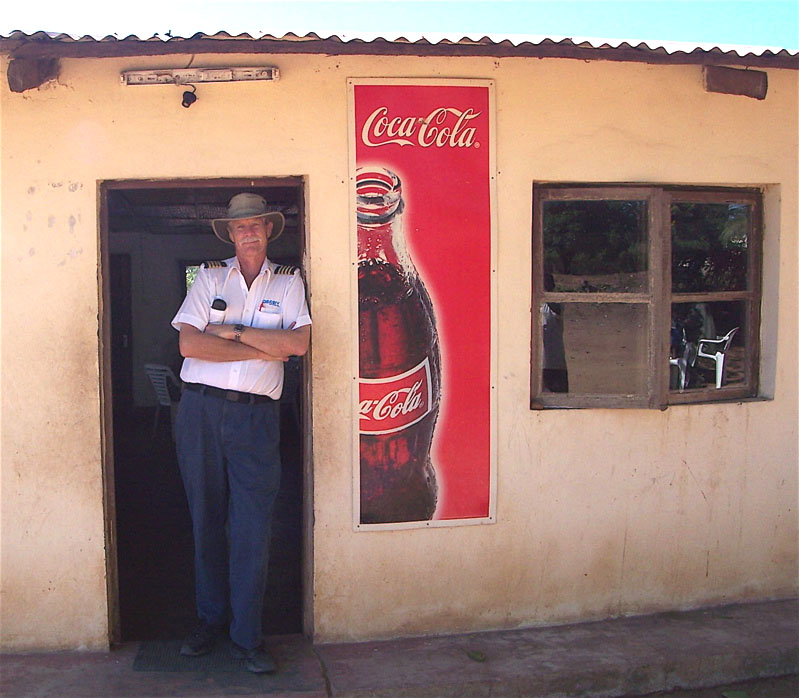
23 May Reminiscing in Caia – May 2007
By Bob Reinaker
I’m in Caia, a small Zambezi river town, sitting on the verandah of a loja (shop) on a white plastic chair at a white plastic table sipping a Coke. It’s the last Friday of the month, payday for Food for the Hungry International (FHI), which translates into two hours in Marromeo, Caia and Gorongosa while we wait for the cash to be handed out to the workers. The town is bustling now with a different crowd than it was 14 years ago when I first visited.
Across the dusty street is a small bar with the white plastic tables and chairs and the same red Coca-Cola sign—the real symbols of development in Africa. Next to the bar is a market spaced with reed mats holding neatly piled pyramids of tomatoes, onions and garlic. Nearby, a man is selling small mounds of nails, screws and other bits of hardware. Bicycles pass, laden with bundles of firewood, cans of oil, cases of beer and Coke; sometimes there is one, even two extra passengers spread out along the frame. An occasional pickup bounces by – mostly white Toyota Hiluxes – stirring up the dust.
The rusting tank lies buried in the tall elephant grass nearby off the main square, the same spot it occupied back in 1992 when Caia was overrun by thousands of refugees flooding from the rebel controlled areas to the south. The brown, sun- baked hulk and a few bullet holes spattered across some of the walls of derelict buildings are the only signs left of the 8-year civil war that followed independence in 1974.
Of course the people were less well-fed then, in fact, many near death. The only food available was being doled out underneath large open tents. I had spent many hours wandering these ruined villages waiting while my World Vision coordinators organized and ladled out plates of beans, cups of powdered milk and mounds of massa. The memories still linger: the only clothes – food sacks hanging off emaciated limbs; the scramble for kernels of corn falling on the ground out of the Russian Antonovs; the clouds of flies hovering around the sweaty bodies and drippy eyes and noses of the children. During these many trips to the Zambezi river towns of Caia, Sena and Murraca, I discovered that hunger was manifested by a leaching away of motion, the shutting down of energy sapping movement, a passivity that I could not experience but only observe, the emptiness in people’s eyes.
In fact, the memories which stick with me of my twelve years of flying over Mozambique are visceral ones. I remember the smell of rotting, gangrenous flesh: a sunny afternoon waiting in Pebane when several white clad nurses approached on foot from the nearby health clinic. They were leading a man with a blood stained, bandaged forearm to the plane. They told me he had been bitten by a crocodile and he needed to go to the Quelimane hospital. I led him to the back of the C206 and he flopped weakly into the only unoccupied seat. When my four Action Aid passengers arrived we departed for Quelimane—about 40 minutes south. After landing in Quelimane we waited for the ambulance. When it arrived, the man was dead, and we matter- of- factly lifted him to the back of the ambulance. Another “first” for me: the first person to die in my airplane.
I remember the way the wife of a man tenderly covered her husband with a filthy sheet. I was sitting in the C206 at Ruasse waiting for passengers, when several people approached carrying a man on an improvised stretcher. He had apparently struck a mine with his hoe while clearing his mashamba before planting. His body was peppered with tiny bloody holes as if a giant bird had pecked his flesh. We loaded him in the back of the C206 and flew 10 minutes to the nearby town of Gurue. I never heard whether he lived or died.
These days my Air Serv missions tend more to slower paced development projects and administration, as opposed to emergencies. Cargo now is laptop computers, not 50 kilo sacks of corn. Medevacs are handled by Falcon jets staffed by professional medical crews and the victims are whisked off to Johannesburg. Air Serv has been flying in Mozambique for over 20 years and a sign of our success is the plastic chairs packed with customers guzzling beer and Coke, the streets plugged with bicycles, the workers receiving their paychecks. I am proud to have played a small part in that success.
——————————————————————————–
Bob Reinaker said that when he’s not flying Air Serv’s Cessna aircraft on missions around Mozambique, most of his time is taken up hanging out at cafes, administering financial solutions and increasing the income of worthy Mozambicans. Born in Pennsylvania, Bob moved to Alaska in 1976. He worked for Air Serv since 1992 and served as a pilot out of Air Serv’s field office in Beira, Mozambique.

